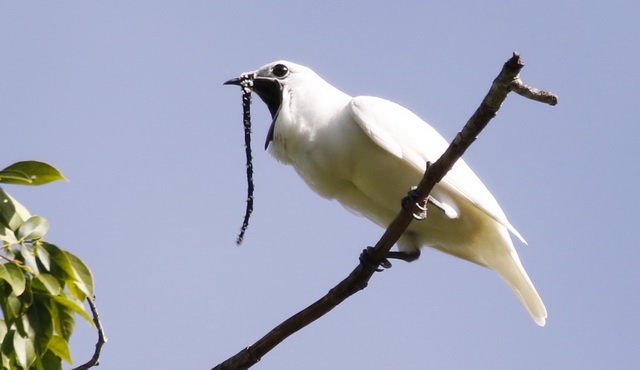Female runs a risk of hearing damage

To seduce a female, a male white bellbird calls out to her so loudly at close range, that she may suffer hearing damage, Jeffrey Podos and Mario Cohn-Haft think. Still, she has to expose herself to the deafening noise.
Not all songbirds have a pleasant song. There are also squeakers, males that call as loudly as possible. Their call definitively is impressive. Up to now, the South American screaming piha, which emits an ear-splitting lashing sound that is characteristic for South-American rainforest, held the record for the loudest bird call.
But now, it turns out not to be the noisiest; it is surpassed by the white bellbird from the northeast of the Amazon. Its call can be three times as loud as that of the screaming piha, Jeffrey Podos and Mario Cohn-Haft discovered. The song consists of two tones and sounds like a horn.
Males of screaming piha and white bellbird do not invest time in raising their young; breeding and feeding are females’ tasks. Males are free and try to mate as many females as possible. To outdo each other in attractiveness, they scream, often in loose groups.
The screaming piha relies completely on its vocalization, as it has a dull appearance. But in the white bell bird, the eye also is to be satisfied. The males are white and have a long black fleshy wattle on their forehead, which dangles along their beak.
Extremely loud
The louder the screaming piha and white bellbird scream, the shorter their call will last, as investigation by Podos and Cohn-Haft showed. Apparently, it is demanding to make such a loud noise. So, females can deduce what a male’s quality is from the volume it produces. Females aim to mate a high-quality male, because that will yield healthy, strong offspring. Moreover, sons of such father will also be able to scream loudly, and so be attractive.
To assess the males’ quality on base of their sound volume, females have to come close to them. For bellbird females, which approach a male up to a meter distance, that is no fun, the biologists think. The males have two versions of their song: they usually shout roughly at the level of the screaming piha. But they are able to call even more loudly, like a pneumatic drill, no less than three times as loud as a screaming piha. A bellbird male is able to produce this sound because of its sturdy muscular body.
Risk
When a female approaches a male closely, he will choose the extremely loud version. He sings the first tone in a crouched position, head and tail bent downwards, his back towards her. Then he swivels around in a split second to blast the second, loudest tone right in her face.
She anticipates, and flutters away when he is about to erupt, but still she is so close that she might suffer hearing damage.
Despite that risk, a female will still join different males, in order to be able to make a choice. It is in his interest to shout as loudly as possible to present himself favourably; it is in her interest to expose herself to that deafening noise, so that she is able to assess his quality.
Willy van Strien
Photo: White bellbird, singing male. ©Anselmo d’Affonseca
Watch and listen to a screaming white bellbird
Compare the sound of screaming piha and white bellbird
Source:
Podos, J. & M. Cohn-Haft, 2019. Extremely loud mating songs at close range in white bellbirds. Current Biology 29: R1055–R1069. Doi: 10.1016/j.cub.2019.09.028